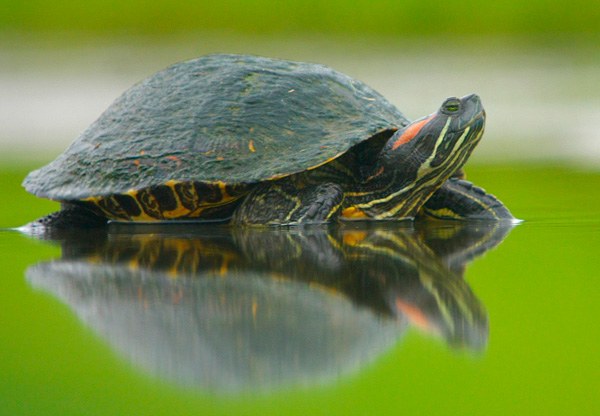In the nature of trachemys is very active at high temperatures. Until +40-+42 degree she feels comfortable basking in the sun, sticking out of the shell's head and paws. With the onset of cooler weather, the turtle becomes lethargic, stops eating, and when air temperature drop to -10 degrees buries itself in sand or silt and falls asleep. But keeping turtles in captivity is different from life in the natural environment.
For a comfortable existence in the home slider turtle is fine enough spacious aquarium-terrarium with clean water at room temperature. Vivariums should be equipped with a small Isle of land on which the turtle could climb. Usually in pet stores is represented by plastic island with suction cups that are attached to the walls of the container.
To maintain the required water temperature in the aquarium you set the thermostat. Also the home of the tortoise is equipped with a lamp to create the level of light and heat. The water in the aquaterrarium should be changed at least once in two weeks. It should be warm and settled. The most suitable for turtles the water temperature +25-+28 degrees.
The diet of turtles is quite extensive. At a young age they can be fed mixtures of dried shellfish purchased at a pet store (dried gamarus). Also happy resident of the home terrarium will eat earthworms, bloodworms, minced meat and beef liver.
In the diet of adult turtles must be "vegetable dishes". Greens salad, leaves, carrot or beet tops, pieces of fruit and vegetables – these products just need the turtle.
Typically, turtles that are kept in apartments, not in need of a long hibernation. With the onset of seasonal cold weather in October and November, the inhabitant of the aquarium can slightly change their behavior. She lost appetite, increases duration of sleep. But in hibernation, it is unlikely to fall, because the apartment is fairly warm and light, and its own "house" and backlit additionally.
On the other hand, the behavior of the turtles, which the owners regard as hibernation, can be dangerous and sometimes fatal disease. Therefore, if the apartment is warm and the turtle is asleep and not moving, it should raise the alarm. First, it is necessary to touch: if the head and limbs are stretched and does not respond to touch, it is likely that the pet died. Live turtle when released in warm water will start to move your legs and try to swim. One sure way to determine if the turtle is to test the reflex of the cornea. If the eye does not respond to touch any object, then the turtle died.
How to keep pond slider turtles
For a comfortable existence in the home slider turtle is fine enough spacious aquarium-terrarium with clean water at room temperature. Vivariums should be equipped with a small Isle of land on which the turtle could climb. Usually in pet stores is represented by plastic island with suction cups that are attached to the walls of the container.
To maintain the required water temperature in the aquarium you set the thermostat. Also the home of the tortoise is equipped with a lamp to create the level of light and heat. The water in the aquaterrarium should be changed at least once in two weeks. It should be warm and settled. The most suitable for turtles the water temperature +25-+28 degrees.
How to feed pond slider turtles
The diet of turtles is quite extensive. At a young age they can be fed mixtures of dried shellfish purchased at a pet store (dried gamarus). Also happy resident of the home terrarium will eat earthworms, bloodworms, minced meat and beef liver.
In the diet of adult turtles must be "vegetable dishes". Greens salad, leaves, carrot or beet tops, pieces of fruit and vegetables – these products just need the turtle.
How to identify a sick turtle or hibernate
Typically, turtles that are kept in apartments, not in need of a long hibernation. With the onset of seasonal cold weather in October and November, the inhabitant of the aquarium can slightly change their behavior. She lost appetite, increases duration of sleep. But in hibernation, it is unlikely to fall, because the apartment is fairly warm and light, and its own "house" and backlit additionally.
On the other hand, the behavior of the turtles, which the owners regard as hibernation, can be dangerous and sometimes fatal disease. Therefore, if the apartment is warm and the turtle is asleep and not moving, it should raise the alarm. First, it is necessary to touch: if the head and limbs are stretched and does not respond to touch, it is likely that the pet died. Live turtle when released in warm water will start to move your legs and try to swim. One sure way to determine if the turtle is to test the reflex of the cornea. If the eye does not respond to touch any object, then the turtle died.




